Saturday, January 24, 2009
A Step-By-Step Guide For An Effective Workout

If you are new to the bodybuilding lifestyle or if you have been a bodybuilder for some time you may already realize that your muscular gains depend on your ability to control three variables: Training, Supplementation and Diet. The effect that each of these three variables will have toward the development of your physique will depend upon how closely each adheres to scientific and physiological principals.
In the article What supplements should you take? I detailed the basic supplements that form the solid basis of a bodybuilders supplementation program. In the articleA step-by-step plan for body fat reduction! I detailed the underlying mathematical, physiological and scientific principals involved in designing a program geared to achieve maximal and safe fat loss.
This article aims to detail how to intelligently construct an effective weight-training program. I will present the underlying physiological and anatomical principals upon which effective weight training regimens are based. At the end of this article you will be able to intelligently create your own effective weight-training program suited to your specific goals and needs.
Considerations
When designing a weight-training regimen several variables must be considered. These are:
- 1. Current Health
2. Personal goals
3. Training Phase
For clarity I will discuss each in detail.
Current Health
The current status of your health is the first element that should be given consideration as this can affect secondary factors like recovery ability, susceptibility to injury and overtraining, and physical limitation.
For example, if a 35-year-old male with a history of back problems were to construct a weight training regimen the efficacy of heavy squats in his leg program or deadlifts in his back program would be questionable. Also, due to his age his recovery ability would be less, as would be his ability to gain strength quickly. This would be due to his decreasing levels of growth hormone and testosterone production. The decline in his androgenic hormone levels would leave him more susceptible to overtraining than his 21-year-old counterpart.
When constructing a weight-training regimen, it is essential that one consider individual history of illness and injury and avoid selecting exercises that will induce injury or irritate preexisting conditions.
Personal Goals
Your personal goals will determine the structure of your weight-training program. For example, do you wish to reduce bodyfat or add mass? Do you wish to remain the same size but gain strength? Perhaps your goal is to rehabilitate an old nagginginjury. Whatever your personal goals may be, your training style and method will be adapted toward those ends.
Training Phase
Your training phase will depend upon your personal goals. Again, do you wish to gain muscle? Then your training phase will be mass building. Do you wish to reduce bodyfat? Then your training phase will be geared for fat-loss.
Regardless of training phase knowledge of the human body and its parts is required. For maximum effectiveness you must understand what you are doing, why you are doing it and what results you expect to get from doing what you do.
The Human Body
 When designing a weight-training regimen knowledge of the human body and its parts is essential. Being able to identify the major parts of the human body is needed in order to know what bodyparts to work, and what exercises serve to work those parts. When working midnight shift in a retail store I encountered a member of the cleaning staff who was about 5'4 and weighed 130lbs.
When designing a weight-training regimen knowledge of the human body and its parts is essential. Being able to identify the major parts of the human body is needed in order to know what bodyparts to work, and what exercises serve to work those parts. When working midnight shift in a retail store I encountered a member of the cleaning staff who was about 5'4 and weighed 130lbs.
While arriving to work one evening he said to me "I can bench press 1000lbs with my legs." Although I did not correct him at the time, it was obvious he was lying. When he accompanied me to the gym for a leg workout two days later he could not even squat 100lbs! When I remarked that I was surprised he could not squat 100lbs when he can bench press 1000lbs "with his legs", he told me that he is used to "only machines."
I told him I never knew machines could go up to 1000lbs! I also told him that I never knew anyone who could "bench press" [a chest exercise] with his or her legs! A coincidence that we did legs right after his comment? Hardly! Unless you want to be like that guy and end up wasting your time in the gym, it is necessary to become familiar with the human body.
The Major Muscle Groups
The major muscle groups that bodybuilders need to be concerned with are:
Pectorals [Chest]:
- Upper
- Middle
- Lower
Deltoids [Shoulders]:
- Anterior [front]
- Posterior [rear]
- Medial [side]
Triceps
- Inner Head
- Outer Head
Biceps
Back
- Latisimus Dorsi
- Erectors
Trapezius
Forearms
Legs
- Quadriceps
- Hamstrings
- Calves
Abdominals
Training Split & Frequency
After you have identified the body parts of concern to bodybuilders, you are able to determine what structures will be the subject of your workouts, when those workouts should occur, and in what order. For your benefit I recommend the following split:
- Day 1: Deltoids, Triceps
Day 2: Back, Traps
Day 3: OFF
Day 4: Legs, Forearms
Day 5: Chest, Biceps
Day 6: OFF
Day 7: OFF
The above schedule, as presented in The Ultimate Mass Building Workout, is deal for many reasons. Because each body part group is worked once per week, this split allows not only for maximum growth potential, but also for total recovery of a body part. This recovery time is needed because of the intensity associated with each workout. The split also allows for three days recovery in a seven-day period. Again, this has to do with intensity and the desire to avoid over-training. While the split above is ideal to avoid overtraining, it is not rigid. It allows the user flexibility. I shall explain.
In bodybuilding there is a principal known as priority training or the priority principle. The priority principal states that whatever bodypart is a priority to work get worked first. Thus on Day 1, if triceps were a weak bodypart or the goal of the bodybuilder was to put on muscle to his / her triceps, triceps would be worked first before shoulders. If shoulders were the priority, they would be worked first before triceps. This flexibility can be applied to every working day.
Here is brief explanation behind the split provided.
Day 1: Deltoids should be worked before triceps as triceps assist in deltoid pressing movements like seated shoulder presses and military presses. To gain maximum benefit from deltoid compound pressing movements, ancillary muscles must not be pre-exhausted.
Day 2: Back and trapezius are worked together because the trapezius is the upper back. Traps are also worked during lower back exercises like deadlifts and chin-ups and wide-grip pull-ups.
Day 3: Recovery from previous two days of intense exercise.
Day 4: Working forearms on leg day allows for the forearms to be worked when they are fresh. During upper body movements forearms may be partially pre-exhausted. Forearms are worked last as one requires their use as stabilizers when performing squats.
Day 5: Chest is worked before biceps as biceps do play a minor role in chest movements like dumbbell flyes and bench press. This allows chest to rest while biceps are being worked and will not result in bicep over training.
Day 6-7: Two days are required to recover from intense exercise.
The above split takes into consideration main and ancillary muscle groups. For example, working triceps on the same day as chest would be overtraining because triceps assist in heavy bench-pressing movements. In the same sense so do shoulders. Thus, the schedule calls for working these body parts on differing days so as to ensure optimal muscular stimulation and avoid overtraining.
Some bodybuilders have recommended working bodyparts such as chest and shoulders together but I never do this. Why? Exactly for the reason given above. Deltoids are worked extensively in pressing movements like flat bench and to a lesser degree in movements like incline bench. Virtually all chest-pressing movements involve the use of the deltoids. Even dumbbell flyes involve the deltoids as stabilizers. While their involvement is limited because of pectoral control over the weight, they still do have a role to play.
Shoulder injuries amongst bodybuilders are common. Thus to avoid injury and overtraining these bodyparts should be worked on different days in your training cycle. The same rationale applies to all bodyparts. To prevent injury and overtraining, be sure to reduce overlap as much as possible.
Exercise Selection
Once you have familiarized yourself with main muscle groups as well as the days on which you are going to train those groups, it is necessary to select exercises according to your stated goals. If your goal is to add mass to your frame compound movements are the logical choice. If you are training to lose bodyfat, the incorporation of isolation movements in the higher repetition ranges is recommended.
For your benefit, compound and isolation movements are explained below:
Exercise Types
All exercise movements, regardless of type [compound or isolation] operate on a ratio basis. Put another way, all movements primarily work one target muscle or group and fiber type, and to a lesser degree another [or other] muscles or muscle groups or fiber type.
Compound movements primarily work one muscle group, and to a lesser degree work others. The term "lesser" is relative as "lesser" is still significant enough to elicit growth from ancillary muscles. Illustrated, the ratio of primary:ancillary stimulation with compound exercises would be 75:25 % respectively. Done in low repetitions compound movements work fast-twitch muscle fibers.
Isolation movements primarily work specific muscles within muscle structures [i.e. the medial deltoid in the deltoid complex]. Illustrated, the ratio of primary:ancillary stimulation from isolation exercises would be 95:5 % respectively. Done in high repetitions isolation movements work slow-twitch muscle fibers. Provided is a brief explanation of each movement type.
Compound
Compound movements are movements that work one specific muscle group more than others but also work the others to a significant degree. The best-known compound movements are the deadlift, squat and flat bench press. Here is a brief explanation of each of the "big three."
Flat Bench Press: The target muscle is the pectorals, but deltoids and triceps also share a significant amount of the work, as they assist in the movement.
Squats: A quadriceps exercise that also involves hamstrings, buttocks, lower back, and abdominals.
Deadlifts: A lower back exercise that also involves the trapezius, deltoids, forearms, abdominals, quadriceps, hamstrings, buttocks.
Compound movements are very effective for inducing muscular hypertrophy when done in low repetitions because of the stimulation of fast-twitch muscle fibers. This stimulation leads to dramatic increases in muscle size and anabolic hormone levels within the body.
Isolation
Isolation exercises exist to isolate specific muscles. Isolation exercises are very effective for brining out muscular definition. This is achieved by the stimulation of slow-twitch muscle fibers, and by the pumping of blood and nutrients into the target muscle by using high repetitions.
The ultimate purpose of an effective weight-training regimen is to train both fiber types. Depending upon training phase, which is dependant upon your goals, the ratio or percentage of fast twitch to slow twitch fiber training will call for adjustment [which is achieved by adjusting repetitions]. The effectiveness of any workout regimen is determined by its ability to adjust the ratio of fast twitch to slow twitch fiber training, in response to your goals. Once you have determined your training split, training frequency, and have determined your training phase and exercise selection, you must calculate percentage values for your weight-training regimen.
1 Repetition Maximum
When reading popular fitness magazines one will see phrases such as "do 12 repetitions at 65%" or "do 7 repetitions at 80%." To many beginners this can be a confusing statement. The question is: 65 or 80 percent of WHAT? To answer this question many beginners often assume that they must "work harder" or "give it more effort." The reasoning is that "if it feels tough I must be working hard." However, this approach is flawed.
The difficulty with expressions and concepts like "work harder", "give it more effort" and "give it all you've got" is that they cannot be defined into concrete term. Put another way, they are totally subjective expressions and cannot be expressed in real-world, workable, terms. Expressions of the subjective type offer absolutely nothing material with which to work and therefore are of little use when attempting to make or measure progress in a weight-training regimen.
In the article Bodybuilding: Its true nature! I discussed the scientific method and outlined how and why bodybuilding is a science. The principles of the scientific method apply here.
When constructing a weight-training regimen, regardless of training phase, one must utilize mathematics to ensure that the program will be effective. To do this it is necessary to establish your one repetition maximum (1RM) for the exercises you have selected.
When formulating a workout plan for muscle gains 1RM is crucial. Thus the utilization of 1RM charts to determine 1RM is recommended.
To calculate your 1RM and to use the 1RM calculations as framework for the construction of a weight-training regimen, use the split provided above, selecting exercises appropriate to your training phase, and record the weights you lift for one week. Click here to determine your 1RM!
When using your 1RM to construct a weight-training regimen, bear in mind the following:
Mass Building Set Guidelines
- For movements that are more compound than isolation use four sets of increasing poundage and decreasing reps.
- For movements that are less compound and more isolation use three sets of increasing poundage and decreasing reps.
Here are the percentages of 1RM you should use per set:
- Exercises using three sets: 1st: 75%, 2nd: 85%, 3rd: 95%
Exercises using four sets: 1st: 65%, 2nd: 75%, 3rd: 85%, 4th: 95%
Isolation / Fat Loss Guidelines:
- For isolation movements use four sets while increasing poundage and keeping repetitions the same.
Here are the percentages of 1RM you should use per set:
- Exercises using four sets: 1st: 45%, 2nd: 55%, 3rd: 65%, 4th: 75%
Bringing It All Together
I shall now provide an example of how to incorporate 1RM values into the construction of a weight-training regimen, regardless of training phase [i.e. mass building or fat reduction]. I will illustrate how poundage increases are achieved in a weight-training regimen and how you can use 1RM calculations to maximize your gains.
Subject Profile:
Sex: Male
Age: 21
Mass: 233lbs
| Exercise | Deadlifts | Squat | Flat Bench Press |
| Poundage (lbs) | 200 | 300 | 250 |
| Repetitions | 10 | 10 | 10 |
| 1RM (lbs) | 267 | 400 | 335 |
In the example the subject performed the three exercises listed and recorded his poundage. He then determined his 1RM by using a 1RM calculator.
Now that the 1RM calculation has been obtained the numbers may be used to calculate the poundage to be done in the following workouts. Consider the following calculations:
200lbs x 10 reps = 267 1RM
215lbs x 7 reps = 267 1RM
255lbs x 2 reps = 267 1RM
The above equations demonstrate that when constructing a mass building or fat loss weight training regimen it is important to gear your sets and poundage so that even though the poundage increases and the repetitions decrease as you move from set one to set three or four, the resultant 1RM value for each set remains the same. Put another way, you need, using a 1RM calculator, to adjust the variables [poundage and reps] so that the resultant [1RM] works out to be equal to the 1RM you initially calculated from your recorded poundage.
But what happens if the poundage values you had recorded previously and your newly recorded values differ? In other words, what happens if your 1RM for a given exercise is 267lbs, and you are able the following week to do 255 for 3 reps instead of two? This is where step 3 of the scientific method [as outlined in Bodybuilding: Its TRUE nature!] comes into play. It states:
- STEP 3: Test those predictions by experiments or further observations and modify the hypothesis in the light of your results.
As mentioned, you recorded your lifts during the first week on the program and you calculated your 1RM. You also manipulated the dependent variables of POUNDAGES and REPETITIONS to keep it consistent with the independent variable 1RM. You then worked out at the gym and recorded how much you were able to lift for a specific number of sets and repetitions. To your surprise you can do 3 reps at 255 instead of 2 reps at 255. This means, simply, that you have increased your 1RM and that you must, therefore, adjust the percentages of each set and the rep and weight values for each set to maintain consistency with the value of your new 1RM.
To illustrate, consider the following:
| Week | Exercise | Poundage | Repetitions | 1RM |
| 1 | Deadlifts | 255 | 2 | 267 |
| 2 | Deadlifts | 255 | 3 | 278 |
In this example, when attempting to determine how much work should be done in the following workout, the layout would appear as follows:
Week 2
1RM: 278
Exercise: Deadlifts
1st set (65% of 1RM): 200lbs x 12 repetitions [278(.65)]
2nd set (75% of 1RM): 210lbs x 10 repetitions [278(.75)]
3rd set (85% of 1RM): 235lbs x 6 repetitions [278(.85)]
4th set (95% of 1RM): 265lbs x 2 repetitions [278(.95)]
Therefore, the following weeks deadlift requirements would appear as above, resulting from the new 1RM.
For your convenience I have included templates that will enable you to record your poundage and repetitions. I have also included a template that will allow you to track the value of your 1RM for the exercises you perform. By updating these you can know for sure if you are becoming stronger over time. Over the course of several months you will be able to visually chart your progress to illustrate your strength gains.
One subject using the principles outlined here constructed a mass building program and gained 30lbs of lean mass in four months, and did so naturally. By using the principles outlined in this article to construct your own weight-training regimen, regardless of training phase, you too can make impressive gains.
Wednesday, January 21, 2009
Developing the Physique of Your Body

Part Bigger Wheels - Becoming Quadzilla...
Volume 3 in our *ss-kicking special workout series is a personal favorite of mine. Unlike everyone else, who loves doing chest or arms to get that "beach body" look or the "I want to impress the ladies" look, I am partial to that dreaded word... Legs.
Let's be honest here: doing legs sucks - but having big wheels is a priority in this f*cked up sport. There has never been a top Olympian competitor that did not have huge quads or full hamstrings.
Any bodybuilder can look like a winner from the waist up, but the tell-all truth is seen from the waist down.
Sure, it is not the body part that will get you laid, like your chest or arms (even that won't work for those of you who have no game), but it is the body part that will separate you from the rest of the wannabes out there.
The excitement is killing me, so without further ado; let's turn you into "Quadzilla"... Alright, maybe not. How about just improving on what you already have?

Big Wheels
Before we start getting into heavy movements I must warn you: a legit leg workout is not for p*ssies or quitters; it is not for the people who work out in a "health club," putting 2 plates on the leg press and squeezing out 15 reps without breaking a sweat. It is not for the men who want to go out on a Friday night after doing legs in the afternoon.
This is the real deal, no bullsh*t. You want it, you're gonna have to work for it... You're gonna have to bust your *ss. Pain is part of the workout. Nausea is also expected. It ain't gonna be pretty and you will be a mess. So for all you wannabe lifters out there second guessing your decision to read this article, quit now. If you got balls, keep reading...

Quadriceps
Let's start out with a warm-up, leg extensions.
 Leg Extensions
Leg Extensions
- Leg extensions are just preparation for what's to come. Getting our knees warmed up is a priority on all leg workouts. Do 4 sets of 12-15 reps. Feel the movement and squeeze at the peak of every rep.
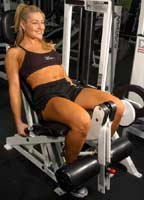 | 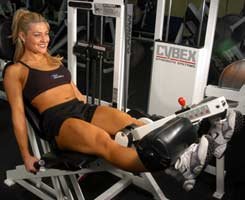 |
 Click Image To Enlarge.
Click Image To Enlarge. Leg Extensions.
Video Guides: Windows Media - MPEG
At the bottom of every rep, do not stop short, but come to a 90 degree angle with your knees. You should feel a nice pump after four sets, enabling you to move on to the hack squat.
 Hack Squat
Hack Squat
The hack squat is a great exercise to develop the lower portion of the quad - you know, the part that no one really has. Since you are already warmed up and started to break a sweat, no need to do another easy set. Let's get right into blasting those quads.
We are going to do 4 heavy sets of 10-12 reps, progressively increasing the weight with each set. And none of this half way down bullsh*t either - *ss to the floor - that's my motto for superior quad development.
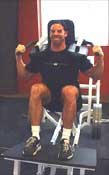 |  |
 Click Image To Enlarge.
Click Image To Enlarge. Hack Squat.
Video Guides: Windows Media - MPEG
The key to this movement is the range of motion - keeping your back flat against the pad and adjusting your feet on the platform so that your knees do not surpass your toes. After your last set of 10 reps, we are going to perform a drop set, which is a lighter set done immediately after your last heavy set, in which you lower the weight and perform as many reps as possible.
In this particular instance, we will do a triple drop set. For example, your last set will be done with 5 plates on each side of the hack, then stripping one plate off between each set and doing another 10-12 reps. You will go from 5 to 4 to 3 to 2 plates on the hack squat on your last set, ultimately performing a total of 40 to 48 reps.
Note:
This is not for the mentally challenged or weak. Push yourself to the limit. There are guys training like this every day, trying to beat you, so you cannot settle for less.
People will be looking at you like you have lost your f*cking mind, but those are also the people who envy the position you are in and want to be as dedicated as you. But what we are looking for is quad development, not compliments... At least not now.
 Leg Press
Leg Press
After you take a few minutes break, you will waddle over to the leg pressmachine. This is another great movement that targets your thighs. After getting some blood back in your head and finding out you can still bend from the knees and are not broken, load up the machine with enough weight to perform your first set of 10 reps.
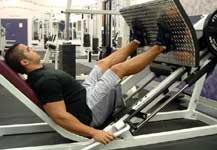 | 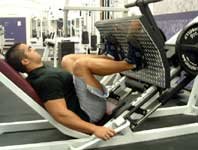 |
 Click Image To Enlarge.
Click Image To Enlarge. Leg Press.
Do not sell yourself short by not putting enough weight on there. Each set you will add more weight, making you work harder to complete your reps. Remember brainiacs, follow that golden rule: knees come down until you can't go anymore. That's right, down to the chest and pushing back up to the top without locking out your legs.
Do you hear it? It is the sound of bodybuilders grueling over the last reps of their sets, knowing that with each proper rep comes an improved physique. After performing your 4 sets, take a rest cuz we are going to squat next.
 Squats
Squats
What am I... f*cking nuts? No, I'm serious; you can't make this sh*t up. This is the part of the workout where winners continue and quitters call it a day. Good thing is that you won't have to use heavy weight, because at this point 135 pounds feels like 405.
No workout would be complete without squats. This is the exercise that gives your legs the thickness to make them stand out on stage. You will do three sets of 10 before you feel like collapsing.
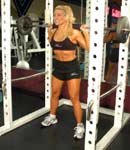 | 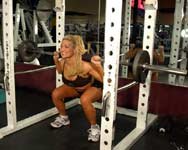 |
 Click Image To Enlarge.
Click Image To Enlarge. Barbell Squat.
Video Guides: Windows Media - Real Player
At this point, I don't have to remind you about your range of motion, especially on this movement. *ss down to China and back up again - that's how low you go. No exceptions.
Better get the bucket ready, because you're starting to feel queasy. Any serious lifter wishes to have a workout like this each time they step in the gym - you feel sick, but you accomplished something.
Quads are done - phew!

Hamstrings
After a few minutes of rest, hamstrings are next on the list. Don't punk out yet. The hard part is done. After your blowout quad workout, your hams should be somewhat pumped.
 Lying Leg Curls
Lying Leg Curls
Let's first start with the lying leg curl, doing 4 sets of 10-12 reps. This should ease some of the pain in the quad area and get the rest of the blood back in your head, enabling you to remember your name.
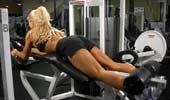 | 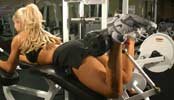 |
 Click Image To Enlarge.
Click Image To Enlarge. Lying Leg Curls.
Video Guides: Windows Media - MPEG
 Standing One-Legged Curls
Standing One-Legged Curls
- Next, limp your way on over to the standing one-legged curl machine where you will again perform 4 sets of 10-12 reps. This is a good exercise to target the upper hamstring and give you that split that is so seldom seen.
 | 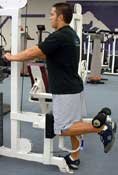 |
 Click Image To Enlarge.
Click Image To Enlarge. Standing One-Legged Curls.
 Stiff-Legged Deadlifts
Stiff-Legged Deadlifts
Finally, just to get a good stretch in the hams and the lower back, you will perform 3 sets of stiff-legged deadlifts for 12 reps each. Always remember to keep your knees bent, chest out, and back flat when performing this exercise. Believe it or not, after this, you will have completed your first workout on the long road to bigger and better legs.
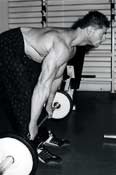 | 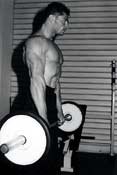 |
 Click Image To Enlarge.
Click Image To Enlarge. Stiff-Legged Deadlifts.
Tuesday, January 13, 2009
the Importance of Nutrition for rapid abs

I hate to break it to you, guys, but 88% of physique is diet. Training without some attention to the types of foods you are eating will make it difficult to reveal yourabdominal muscles. Diet alone won't do it all either, but it is the biggest key.
For some, it is not such an effort because they may have better genetics toward staying on the leaner side, such as the classic ectomorph or a very highmetabolism naturally but if you are not showing a six-pack with all your efforts, then you know you are not one of those lucky naturals - so you need to work at it a bit more like the majority of us!

Importance Of Water & Supplements
To lean down, you must consume the right combination of foods in order for that 6-pack to show. Water is essential to help flush you clean and function optimally, so aim for an average of 2 liters per day.
| WATER INTAKE CALCULATOR |
Supplements are great but not necessary for this goal, although if you are going to add some to your diet, then I would test out some creatine and glutamine as well as finding a nice multivitamin to aid in your diet process. The multis are a minimum and the reason I personally suggest them is because foods today are just so denatured through process and travel.
Creatine can be a great boost for the right people, so all you can do is try it out and see how it affects your game! Glutamine is great especially if you are the workhorse type who trains to pain. Glutamine might offset this, and although never proven outright, there are too many individuals who have found its uses to be very evident to them, myself included.
Creatine can cause some individuals bloat and it can also depend on the type and form of creatine, so go into this knowingly when trying out these products.

Importance Of Whole Foods
 The choice whole foods which you would concentrate on are simple, repetitive, and in many cases quite bland and uneventful, but no one said this has anything to do with taste! Eating this way is also very healthy and your body will love it!
The choice whole foods which you would concentrate on are simple, repetitive, and in many cases quite bland and uneventful, but no one said this has anything to do with taste! Eating this way is also very healthy and your body will love it!
Items such as garlic, green onions, lemons, limes, chili's and non-sodium products such as Mrs. Dash are all excellent additions to spice up the flavors of your food. Too much sodium could end up sitting as water across your belly so I would try to keep it low.
Concentrate your 6 meal-per-day average to the following items, spreading meals out every 2-3 hours (including snacks):
- Lean proteins (grilled fish or poultry), as these will help get your basic protein nutrients without too many added fats.
- Fibrous green vegetables (mixed greens, green beans, spinach and broccoli) which are great filler and loaded with phytochemicals.
- Limited complex carbohydrates (sweet potatoes, quinoa or brown rice) which are your starch compliment to your diet, a needed part to the puzzle.
- Omega fats (avocado, olives and almonds) which are the dietary fats youwant, they are essential fatty acids (or EFA's) and help you with your fitness and health goals while replacing the bad fats you have eliminated. I like Udo's Oil.
- Limit sugars, fruits, juices, breads and pastas which I always suggest to save for a cheat day or cheat meal per week depending on how strict you are with your diet.
- Eat every 2-3 hours to increase metabolism and keep the muscles happy! If you skip meals, your body will slow the metabolism, defeating your goals!
All these factors are extra necessary for those who are consistently active or insports. Functions are optimal in this environment making your success all the more tangible. When you play hard, you need to eat hard!

Example Meal Plan
An example of a leaning meal plan would go as follows:
 Meal One
Meal One
Try a grapefruit with some egg whites for breakfast.
 Meal Two
Meal Two
2 to 3 hours later, some plain oatmeal made up of water and plain raw oats. A teaspoon of raisins or cran-raisins can be added for sweetness.
 Meal Three
Meal Three
Simple lunches can be a few cups of raw greens topped with 4-6 ounces of grilled chicken or fish, a ½ cup of yams with a simple vinaigrette dressing (I like to use Udo's oil and balsamic or lemon juice with grainy mustard), and some almonds for crunch.
 Meal Four
Meal Four
Protein drinks make for a great snack. Add a few frozen strawberries to blend your protein powder and water into a smoothie, perfect for a summer treat!
 To List The 50 Top-Selling Protein Powders,
To List The 50 Top-Selling Protein Powders, Meal Five
Meal Five
Same idea as lunch, except you can add a ½ cup of grain (such as brown rice or quinoa) to the meal. You could also substitute some cooked green beans instead of the salad for variety.
 Meal Six
Meal Six
Same as meal #4.




